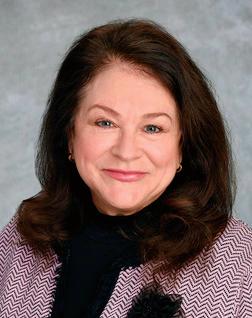
4 minute read
How COVID is Changing Medicine - Letter from the President
In 2020 - this most unusual of years - many things are uncertain, but we know without question that COVID-19 is changing medicine. In this Fall 2020 issue of Arizona Physician, we focus on some of those changes and their impact on physicians, patients, and the health of the public.
As we go to press, there are over 7.5 million COVID-19 cases in our country, and 235,000 cases in our state of Arizona, with 223,000 deaths nationwide and almost 6,000 deaths in Arizona due to COVID-19. Before 2020, most physicians would never have believed that we would become so interested (and self-educated) in infectious disease and public health, yet necessity is the mother of invention, as we have become the “go-to” source of COVID-19 information for our patients, families, friends and neighbors. We have attended fewer CME courses this year, but have spent far more time reading and learning -- about COVID-19 and all of its ramifications across a broad spectrum of medical specialty areas as well as about government and public health agencies – and also about new technology to assist us in our practices.
Telemedicine
Probably the most obvious technological change for most of us is the rapid pivot to telemedicine for some (or all) of our clinical work. It appears that telemedicine is here to stay, for better and for worse. It clearly reduces the risk of infection exposure to patients, staff, and physicians, and has been generally well-received by all parties. Although we may have found some challenges and limitations in our diagnostic abilities without the usual methods of physical examination accompanied by visual/facial cues and body language, we have gained a more 3-dimensional biopsychosocial approach to treating patients, peering into their homes and personal lives, meeting their family members and pets, gaining a better understanding of their challenges and support systems. We’ve gained family members who can listen and watch the phone and video encounters, the “second parent” who can’t be in the room, extended family members helping with translation, a parent helping a 19-year old child navigating the medical system on their own for the first time. Technology allows family members to say good-bye to loved ones via FaceTime. As one local physician said, “I’m so glad we have the technology, but so sad we need it so much.” Corporate medicine is delighted to provide personalized portals and apps to connect patients more closely to their physicians, but physicians are finding that 24/7 connection to be a mixed bag, blurring the boundaries between work and homelife. New technologies for remote monitoring and wearables will inevitably replace in-person care to some extent, and this increased data may improve the quality of medicine that we provide.
PPE & Physician Stress
Many of our patients have avoided acute and routine care this year due to fear of infection and our practice limitations. This fall we are facing a “catch-up” period as we go into flu season and the ongoing COVID pandemic. We are still frustrated by our inability to obtain proper PPE at reasonable prices for in-person patient care. We have had to become creative to preserve our precious PPE, instituting blocks of clinic time and “curbside” care to minimize PPE usage. This shortage, along with awareness of possible transmission from asymptomatic people and unreliable testing, causes new anxiety with patient encounters, as every encounter potentially endangers the physician and his/her family. This often results in the physician standing as far away as the room allows and spending less direct contact time in the room with patients.
As our stresses mount due to the financial impact of COVID on our practices, we are also stressed by the burden of having to learn new technology in a short period of time. Our support staff has scaled down, and we have had to take on the burden of administrative tasks in addition to our clinical work. Employed physicians continue to face lack of administrative support from their corporations and institutions just when they most need to preserve bandwidth to handle the new diagnostic and technological challenges.
Where Does It End?
At a time when our nation needs stability and leadership, our trust in government agencies such as the FDA and CDC has been eroded by inconsistencies and lack
of transparency. Public health decision-making seems to be based more on politics than on science. Consequently, our patients’ trust in our medical advice and science has been damaged, which carries over to upcoming COVID-19 vaccines. Physicians already face the challenge of educating patients that established vaccines are safe and effective. The idea of “Operation Warp-Speed” approval of a COVID-19 vaccine has frightened many patients, with recent polls showing it will have a low acceptance rate. To achieve herd immunity, we need a vaccine that is at least moderately effective and is widely administered. To be able to advocate for such a vaccine, we ourselves need to be able to trust that the vaccine is not only effective but safe. This will require transparency from our public health agencies to assure the medical and scientific community that all safeguards are in place to move forward, with no political considerations.
Physicians are speaking up to administrations, contributing to PACs, running for office, fighting for our patients and for each other. We realize that we are empowered by this fellowship with other physicians, and that we are stronger by working together. For these reasons and so many more, I encourage you to take advantage of all that our Maricopa County Medical Society can offer you, as a current or future member.
By Lee Ann Kelley, MD, Board President, Maricopa County Medical Society (MCMS), president@mcmsonline.com










